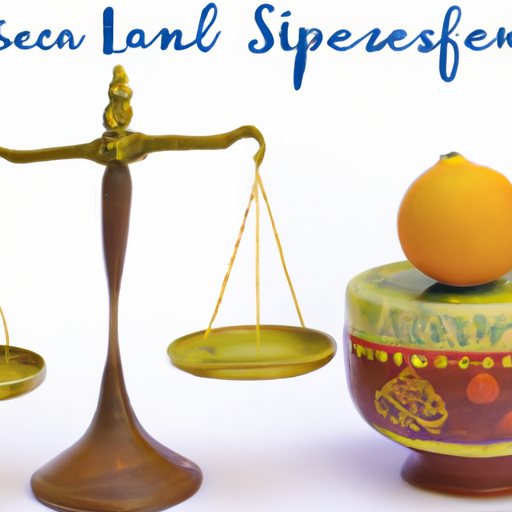Finding the right balance between short-term pleasures and long-term financial security may seem like a daunting task, but with a few thoughtful considerations, it is certainly achievable. It is natural to want to indulge in immediate desires, whether it’s splurging on a fancy dinner or booking a spontaneous vacation. However, it is equally important to prioritize saving for the future and securing your financial stability in the long run. This article will explore practical tips and strategies to help you strike a harmonious balance between enjoying life’s little luxuries now and ensuring a secure financial future for yourself.
Understanding Financial Priorities
When it comes to managing your finances, it’s essential to understand your financial priorities. While it’s tempting to indulge in short-term pleasures, such as shopping sprees or fancy vacations, it’s equally important to identify and work towards long-term financial goals. By striking a balance between immediate gratification and future financial security, you can set yourself up for a stable and prosperous future.
Recognizing short-term pleasures
We all have short-term desires, and it’s okay to indulge in them from time to time. Whether it’s treating yourself to a weekend getaway or buying that designer handbag you’ve had your eye on, these pleasures bring joy and excitement to our lives. However, it’s crucial to recognize and acknowledge these short-term desires so that they don’t overshadow your long-term financial goals.
Identifying long-term financial goals
Long-term financial goals are crucial for building wealth and financial security. They may include objectives like buying a house, saving for your children’s education, or ensuring a comfortable retirement. Identifying these goals allows you to prioritize and allocate your financial resources accordingly. By envisioning your desired financial future, you can better focus your efforts on making it a reality.
Creating a Budget
One of the foundational steps towards achieving financial balance is creating a budget. A budget helps you assess your income and expenses, enabling you to allocate funds effectively.
Assessing income and expenses
Start by evaluating your income sources, including your salary, investments, and any additional income streams. Then, track your expenses meticulously for a month to get a clear picture of where your money is going. This evaluation will help you identify any areas where you may want to cut back and give you a realistic understanding of your financial situation.
Allocating funds for short-term pleasures
While budgeting may seem restrictive, it’s important to remember that it’s also about finding a balance. Allocate a portion of your budget for short-term pleasures, allowing yourself the freedom to enjoy some immediate gratification without compromising your long-term financial goals. This will help you avoid feeling deprived while still making progress towards your larger objectives.
Allocating funds for long-term financial security
Equally important is allocating funds towards long-term financial security. Consider the savings and investments needed to achieve your goals, such as creating an emergency fund, saving for retirement, and investing in assets that grow over time. By setting aside a portion of your income for these purposes, you’ll be actively working towards your long-term financial health.
Setting financial goals
Within your budgeting process, it’s essential to set specific financial goals. These can be short-term or long-term objectives that align with your overall financial priorities. Setting goals provides clarity and motivation, helping you stay on track and make informed decisions about your financial choices.

Prioritizing Saving
Saving money is a crucial aspect of balancing short-term pleasures with long-term financial security. Prioritizing saving can set you up for a more secure future and provide a safety net for unexpected expenses.
Building an emergency fund
An emergency fund is a key component of any financial plan. It helps cover unexpected expenses, such as medical bills or car repairs, without derailing your budget or resorting to high-interest debt. Aim to save three to six months’ worth of living expenses in your emergency fund, gradually building it over time.
Saving for retirement
Saving for retirement is another vital long-term goal. The earlier you start contributing to a retirement fund, the more time your investments have to grow. Work towards maxing out your retirement contributions each year, taking advantage of any employer matching programs, and exploring different retirement savings options, such as individual retirement accounts (IRAs) or employer-sponsored 401(k) plans.
Investing in long-term assets
To further prioritize saving, consider investing in long-term assets that have the potential to appreciate over time. This can include investing in stocks, real estate, or other investment vehicles that align with your risk tolerance and financial goals. By investing wisely, you can grow your wealth and create additional financial security for the future.
Managing Debt
Managing debt is another critical aspect of finding a balance between short-term pleasures and long-term financial security. Understanding different types of debt, prioritizing repayment, and minimizing high-interest debt are key strategies for maintaining a healthy financial picture.
Understanding different types of debt
Not all debt is created equal. There are various types of debt, such as mortgages, student loans, credit card debt, and personal loans. It’s important to understand the terms, interest rates, and repayment schedules associated with each type of debt. This knowledge will help you make informed decisions about how to prioritize your debt repayment and minimize the negative impact of high-interest debt.
Prioritizing debt repayment
When managing your debt, it’s essential to prioritize repayment based on factors like interest rates, outstanding balances, and the impact on your overall financial goals. Consider utilizing strategies like the debt snowball or debt avalanche methods. The debt snowball method focuses on paying off debts with the smallest balances first, while the debt avalanche method prioritizes debts with the highest interest rates. Choose the method that aligns best with your personal financial situation and motivation.
Minimizing high-interest debt
High-interest debt, such as credit card debt, can quickly become a financial burden and hinder your progress towards long-term financial security. Minimize high-interest debt by paying more than the minimum payment each month and exploring options to lower your interest rates. Consider transferring balances to credit cards with lower interest rates or obtaining a personal loan to consolidate debt at a more favorable rate.

Developing a Long-Term Financial Plan
To achieve a well-rounded financial approach, it’s beneficial to develop a long-term financial plan. This plan should incorporate your financial goals, working with a financial advisor, setting realistic expectations, diversifying investments, and regularly reassessing your progress.
Working with a financial advisor
A financial advisor can provide valuable guidance and expertise in helping you create and execute a long-term financial plan. They can assist in setting realistic goals, optimizing your investment strategy, and providing ongoing support and education. Collaborating with a financial advisor can give you the confidence and knowledge you need to make informed financial decisions.
Setting realistic expectations
While it’s crucial to dream big and set ambitious financial goals, it’s equally important to set realistic expectations. Understand that progress may be gradual, and setbacks may occur along the way. By setting attainable milestones and celebrating small victories, you’ll be more motivated to continue on your path toward long-term financial security.
Diversifying investments
A key element of a long-term financial plan is diversifying your investments. This means spreading your investments across different asset classes, industries, and geographic locations to minimize risk. By diversifying, you can potentially maximize your returns and protect yourself against significant losses in any one area.
Regularly reassessing the plan
Financial plans are not set in stone and should be regularly reassessed and adjusted as needed. Life circumstances, economic conditions, and personal goals may change over time, requiring modifications to your plan. Schedule regular check-ins with yourself or your financial advisor to review your progress, reassess your goals, and make any necessary updates to your long-term financial plan.
Tracking Expenses
An essential part of maintaining financial balance is tracking your expenses. By using budgeting apps or spreadsheets, categorizing expenses, identifying areas to cut back, and avoiding impulsive purchases, you can better manage your spending habits.
Utilizing budgeting apps or spreadsheets
Budgeting apps or spreadsheets can be extremely helpful tools for tracking expenses, managing budgets, and gaining insights into your overall spending habits. These tools allow you to input and categorize your expenses, create spending limits, and visualize your financial progress. Explore different options to find the app or spreadsheet that best suits your needs and preferences.
Categorizing expenses
Categorizing your expenses is essential for gaining a clear understanding of where your money is going. Create categories such as housing, transportation, groceries, entertainment, and debt payments. Regularly review and analyze your expenses within each category to identify areas where you may be overspending or where there is potential for cost-cutting.
Identifying areas to cut back
Tracking your expenses also helps you identify areas where you can cut back and save more. Look for patterns of excessive spending or areas where your spending does not align with your financial goals. For example, if you notice that you’re spending a significant amount on dining out, consider meal prepping at home or limiting your restaurant visits. By making conscious decisions to reduce unnecessary expenses, you’ll have more resources available to prioritize your long-term financial security.
Avoiding impulsive purchases
Impulse purchases can quickly derail your financial progress and hinder your ability to achieve a balance between short-term pleasures and long-term financial security. Before making any non-essential purchase, take a step back and ask yourself if it aligns with your financial goals and budget. Consider implementing a waiting period before buying anything impulsively, allowing time for reflection and a reassessment of whether the purchase is necessary or not.

Creating Short-Term Rewards
While long-term financial security is essential, it’s equally important to reward yourself along the way. Creating short-term rewards allows you to celebrate milestones and enjoy the fruits of your labor without derailing your financial progress.
Setting achievable milestones
Break down your long-term financial goals into smaller, achievable milestones. For example, if you’re saving for a down payment on a house, set milestones for reaching specific savings amounts. Celebrate each milestone by treating yourself to a small reward or indulgence that you’ve budgeted for. This approach allows you to enjoy short-term pleasures while staying focused on your larger objectives.
Rewarding yourself within budget
When creating short-term rewards, it’s vital to prioritize budget-friendly options. Look for activities or experiences that bring you joy without breaking the bank. For example, plan a picnic in the park, have a movie night at home, or try out a new recipe instead of dining at an expensive restaurant. By finding inexpensive or free alternatives, you can enjoy the experience guilt-free, knowing that it aligns with your long-term financial goals.
Finding inexpensive or free activities
There are numerous inexpensive or free activities that can provide entertainment, relaxation, and a sense of reward. Explore local community events, visit museums on discount days, or take advantage of outdoor recreational areas. Engaging in these activities allows you to enjoy yourself in the present without compromising your long-term financial security.
Finding a Balance
The ultimate goal is to find a balance between short-term pleasures and long-term financial security. It requires evaluating trade-offs, weighing the importance of different goals, and making conscious spending decisions.
Evaluating trade-offs
Maintaining balance often involves evaluating trade-offs between competing financial priorities. For example, if you’re planning a luxurious vacation, it may require sacrificing other short-term pleasures or delaying progress towards a long-term financial goal. By carefully considering the trade-offs, you can ensure that your choices align with your overall financial priorities.
Weighing the importance of short-term and long-term goals
When facing conflicting financial goals, it’s important to weigh their respective importance. Consider the potential long-term benefits and the overall impact on your financial well-being. While short-term pleasures provide immediate satisfaction, remember that long-term financial security is a lasting investment in your future stability and peace of mind.
Making conscious spending decisions
Achieving balance necessitates making conscious spending decisions. Before making a purchase or committing to an expense, take a moment to reflect on whether it aligns with your financial priorities and goals. Consider the long-term impact of your spending choices and whether they are in line with your overall financial plan. This mindfulness will allow you to make more informed decisions and maintain balance in your financial life.

Seeking Accountability and Support
Maintaining a balanced financial approach can be challenging on your own. Seeking accountability and support from trusted friends, family members, financial communities, or participating in challenges or accountability programs can provide encouragement and guidance along the way.
Sharing goals with a trusted friend or family member
Sharing your financial goals with a trusted friend or family member can provide a sense of accountability and support. By discussing your aspirations, sharing progress updates, and seeking advice, you’ll have someone to help keep you motivated and on track. Additionally, their perspective and experiences may offer valuable insights into managing finances.
Joining financial communities
Joining financial communities, whether online or in-person, can provide a supportive network of individuals with similar financial goals. These communities often offer resources, discussions, and opportunities for learning from others’ experiences. With a wealth of knowledge and a shared commitment to financial balance, these communities can support and inspire you on your financial journey.
Participating in challenges or accountability programs
Challenges or accountability programs are designed to help individuals stay on track with their financial goals. They often provide a structured framework, milestones, and resources to help participants develop healthy financial habits. Engaging in these programs can provide the external motivation and support needed to maintain a balanced financial approach.
Conclusion
Achieving a balance between short-term pleasures and long-term financial security is a journey that requires careful consideration and planning. By recognizing short-term desires, identifying long-term goals, creating a budget, prioritizing saving, managing debt, developing a long-term financial plan, tracking expenses, creating short-term rewards, finding a balance, and seeking accountability and support, you can navigate the complexities of managing your finances. The benefits of a well-rounded financial approach include a financially secure future and the ability to enjoy life’s pleasures while staying on track towards your larger goals. Remember, striking a balance is key to ensuring both present enjoyment and long-term peace of mind.


